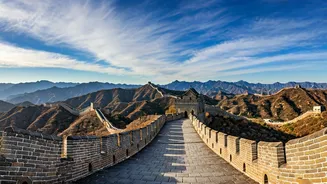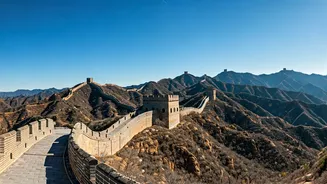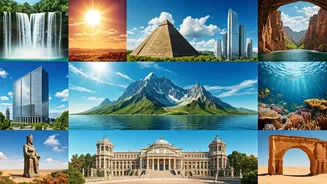Great Wall of China
The Great Wall of China is a colossal fortification project of immense historical and architectural value. It snakes across the northern borders of China,
constructed and maintained over centuries by various dynasties. Its primary purpose was to protect the Chinese Empire from invasions. This massive structure stands as a testament to the ingenuity and perseverance of the Chinese people, representing a significant aspect of Chinese culture and history. Its scale and design demonstrate how they utilized their resources and abilities, contributing to its status as a significant world wonder.
Petra, Jordan
Petra, located in Jordan, is an ancient city that was carved into sandstone cliffs. This city was the capital of the Nabataean Kingdom, flourishing as a major trading hub in ancient times. Its unique architecture, with structures directly sculpted into the rock faces, gives Petra its distinctive appearance. The Treasury and the Monastery are among the most notable structures, representing impressive engineering achievements. The city's location within a narrow gorge made it a strategic and secure location, reflecting the Nabataeans' mastery of their environment.
Colosseum, Rome
The Colosseum in Rome is an iconic amphitheater, known for its significant role in ancient Roman entertainment. Constructed during the Flavian dynasty, it could accommodate tens of thousands of spectators who came to watch gladiatorial contests and public spectacles. The Colosseum's architectural design, including its arches and vaults, represents a high level of Roman engineering. Despite being partially ruined, it continues to evoke admiration for its historical significance and stands as a symbol of Roman power and the empire's legacy, making it one of the most recognizable monuments in the world.
Chichen Itza, Mexico
Chichen Itza in the Yucatán Peninsula of Mexico is a large pre-Columbian city built by the Maya civilization. Its most notable structure is the Temple of Kukulcan, or El Castillo, a stepped pyramid. The city also features other important architectural elements, like the Temple of the Warriors and the Great Ball Court. It served as a major center for religious, political, and economic activity during its time. The alignment of its structures with astronomical events underscores the Mayans' sophisticated understanding of astronomy and their ability to integrate it into their daily life.
Machu Picchu, Peru
Machu Picchu, nestled in the Peruvian Andes, is an ancient Inca citadel. It was built in the 15th century, possibly as an estate for the Inca emperor Pachacuti. The site features well-preserved structures, including temples, palaces, and residential areas, constructed using precisely fitted stone blocks. The location of Machu Picchu high in the mountains and its sophisticated stonework reveal the Incas’ engineering and architectural skills. The site's significance lies in its role in Inca culture and history, offering insights into their societal and religious practices, and its lasting legacy.
Taj Mahal, India
The Taj Mahal, situated in Agra, India, is a majestic ivory-white marble mausoleum. It was commissioned in 1632 by the Mughal emperor Shah Jahan to honor his wife, Mumtaz Mahal. Its architecture combines elements of Persian, Indian, and Islamic styles, resulting in a unique and visually striking design. The Taj Mahal's symmetrical structure, intricate carvings, and the use of precious stones provide a stunning display of craftsmanship. It stands as a symbol of love and a profound example of Mughal architecture, attracting visitors from around the world.
Christ the Redeemer, Brazil
Christ the Redeemer is an iconic statue of Jesus Christ atop Corcovado Mountain in Rio de Janeiro, Brazil. Completed in 1931, the statue is a symbol of Christianity and a welcoming gesture to the city. The statue's design incorporates elements of Art Deco style, and its location provides panoramic views of Rio de Janeiro. It is made of reinforced concrete and soapstone and has become a landmark, representing faith and hope for the people of Brazil. This monument has a significant impact on local identity, drawing visitors and contributing to the global image of the city.
The Roman Forum
The Roman Forum, located in the heart of Rome, served as the center of ancient Roman life. It was a place for public meetings, markets, religious ceremonies, and trials. The forum was surrounded by important buildings, like temples, basilicas, and government offices. Its strategic location made it the center of political, religious, and social activities. Today, the ruins of the Roman Forum offer insights into the daily lives, political structures, and cultural practices of the Roman Empire, attracting historians and tourists who appreciate history.
The Great Pyramid, Giza
The Great Pyramid of Giza in Egypt, also known as the Pyramid of Khufu, is an ancient monument. Constructed around 2580–2560 BC, it served as a tomb for the pharaoh Khufu. Its massive size and intricate internal structures represent an astounding engineering feat. The pyramid's alignment with cardinal directions and the precision of its construction continue to intrigue researchers. The Great Pyramid stands as a symbol of ancient Egyptian civilization, showcasing their advanced architectural, mathematical, and organizational skills. It is an enduring testament to their legacy.













